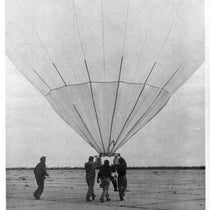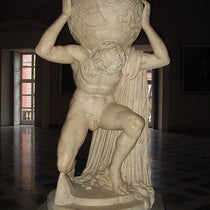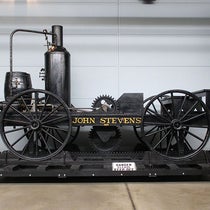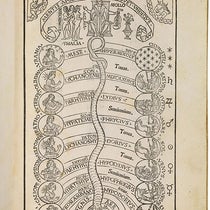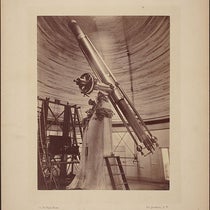Scientist of the Day - John Franklin
John Franklin, a British naval officer and Arctic explorer, died June 11, 1847, at the age of 61. Franklin was at the time in charge of the Franklin Expedition, which had left England in 1845, seeking to complete the search for a Northwest Passage through the Arctic archipelago, of which only some 900 miles remained to be explored. It is sometimes referred to as the lost Franklin expedition, since all 129 members of the crew disappeared and were never seen seen again alive. The two ships, HMS Erebus and Terror were recently discovered (2014 and 2016) in the waters off King William’s Island in the Arctic.
Franklin had first entered Arctic service in 1818, when the search for a Northwest passage across North America to the Pacific began in earnest, spearheaded by the Second Secretary of the Admiralty, John Barrow. Franklin was lieutenant commander of a ship on the first expedition, and then led two land expeditions,1819-22 and 1825-27, up north through what is now Canada to the Arctic coast. Both were successful and mapped a large part of the Arctic coastline. Franklin published well-illustrated narratives for both overland expeditions, about which we have written a post.
Franklin then commanded a Mediterranean vessel for a while, sat idle for a few years on half pay, and finally accepted appointment as Lieutenant Governor of Van Diemen's Land (now Tasmania) in 1837. This was not a happy time, as he was not on a ship, and there were many political problems. The only bright spot was his marriage to Jane Franklin, known as Lady Jane, who was a very popular figure wherever they went. Nevertheless, John was recalled in 1843 by the Colonial Secretary and was once again without portfolio.
About this time, Barrow convinced the Prime Minister to outfit one last expedition to complete the Northwest passage. Franklin lobbied hard for the command, and when James Clark Ross turned it down, Franklin got the nod. He was 59 years old. The Erebus and Terror had recently returned from Antarctica (commanded by Ross), and they were refurbished and equipped with steam engines and screws for auxiliary power to assist in getting through obstinate ice packs. The ships were laden with provisions for three full years, mostly in the form of tinned goods. They set off in May of 1845 and were spotted later that summer in Lancaster Sound off Baffin Bay. The ships and crew were never seen again, except in the mind’s eye of artists (third image). A modern map provides a conjectured path of the ships through the archipelago to their (almost) final resting places (second image)
The story of Arctic exploration for the next 13 years was essentially a search for Franklin and his ships and crew. More than 40 expeditions were sent out, beginning in 1848, including two American ones. Three graves of crewmen were found on Beechey Island in 1850 (fourth image), and further discoveries suggested the ships went south from there, toward King William’s Land (now Island), and then disappeared. John Rae in 1854 learned from local Inuit that men had been observed trekking south and that there was evidence of possible cannibalism (which did not go over well with Lady Franklin), and the Inuit had physical evidence in the form of dinnerware and insignia that could only have come from the Erebus and Terror. And then in 1859, commanding a ship owned by Lady Franklin, Francis McClintock found a document at a cairn on King William's Land describing the abandonment of the ships and providing the death date of John Franklin. You can see that document at our post on McClintock.
No one is sure why everyone died, with lead poisoning (from badly soldered tins), botulism, and malnutrition all being suspected, to say nothing of the cold. And no one knows how the ships got from their frozen-in locations north of King William's Land to the harbors where they have recently been discovered. But it is generally agreed that Franklin's assigned mission was ultimately accomplished, because the ships searching for Franklin finished mapping and traversing what was left to be discovered of the Northwest Passage.
Lady Franklin saw to it that her husband was properly honored in memory, and there are statues of Franklin all over, including London (fifth image), his birthplace in Spilsby in Lincolnshire (sixth image), and even in Hobart, Tasmania. There is also a plaque with bust in Westminster Abbey. Our 2008 exhibition, Ice: A Victorian Romance, had an entire section on "The Search for Franklin,” which you can find online here. We have also published posts on many of the participants, including Horatio Austin, Elisha Kent Kane, Samuel Cresswell, Joseph Bellot, Henry Kellett, Sherard Osborn, and Robert McClure. We have even written posts on HMS Erebus and HMS Terror. And if that is not enough, there is an immense body of literature on the search for Franklin just waiting for your inquiries.
William B. Ashworth, Jr., Consultant for the History of Science, Linda Hall Library and Associate Professor emeritus, Department of History, University of Missouri-Kansas City. Comments or corrections are welcome; please direct to ashworthw@umkc.edu.








